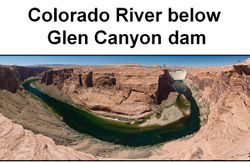Difference between revisions of "GCDAMP Glen Canyon Dam"
From Glen Canyon Dam AMP
(fix) |
(add loss rates from lake powell) |
||
| Line 3: | Line 3: | ||
---- | ---- | ||
[[File:Glen Canyon Dam- Down River- USGS.jpg|250px]] | [[File:Glen Canyon Dam- Down River- USGS.jpg|250px]] | ||
| + | |||
| + | ---- | ||
| + | *JAWRA_ Loss Rates from Lake Powell and their impact on management of the Colorado River_Tom Myers_feb 20, 2013 | ||
| + | **Estimated that more than '''14.8 billion cubic meters has been stored in the banks, with a 90% probablility that the value is actually between '''11.8 and 18.5''' (Gm 3) | ||
| + | **The Colorado River has '''73.4''' billion cubic meters of available storage in its 10 largest reservoirs (USBR, 2011), which is approximately four times the river's average annual flow. | ||
| + | **Lake Powell loses water from the river system in two ways: to '''evaporation''' from the free water surface and '''bank seepage'''. | ||
| + | **Bank Seepage is flow to the banks that does not return to the river system whereas bank storage may return to the reservoir or river system. | ||
Revision as of 11:14, 10 July 2013
- JAWRA_ Loss Rates from Lake Powell and their impact on management of the Colorado River_Tom Myers_feb 20, 2013
- Estimated that more than 14.8 billion cubic meters has been stored in the banks, with a 90% probablility that the value is actually between 11.8 and 18.5 (Gm 3)
- The Colorado River has 73.4 billion cubic meters of available storage in its 10 largest reservoirs (USBR, 2011), which is approximately four times the river's average annual flow.
- Lake Powell loses water from the river system in two ways: to evaporation from the free water surface and bank seepage.
- Bank Seepage is flow to the banks that does not return to the river system whereas bank storage may return to the reservoir or river system.

